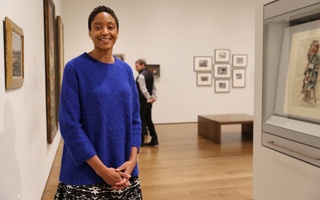On Jan. 26, students and members of the Harvard community filled the Carpenter Center for the debut of Katy Grannan’s film, “The Nine.” Grannan is a photographer and filmmaker who lives and works in the Bay Area. Prior to her most recent work, she produced a short film titled “Are You Listening?”. Made before the 2016 presidential election, the video is a compilation of clips that Grannan captured while travelling across America, overlaid with narration by Cherry Jones. First published on The New Yorker website in late October, the film aimed to take a temperature of American attitudes leading up to the election, through the narratives and visual scenes.
For her most recent film, Granna examines an area in California’s Central Valley. South Nine Street, also known as the Nine, is depicted as a center of deterioration of society. In the film, Grannan provides a look into the lives of residents of the Nine, who are not so far estranged as their world seems to be.
“I felt their stories needed to be heard,” Grannan said. “It’s part of an invisible America that’s all around us. It’s part of us.”
Grannan, who grew up down the street from Harvard in Arlington, Massachusetts, embraced the debut of her film near her roots.
“It’s pretty special to be so close to home. A lot of my family is here, old friends, neighbors,” she said.
“The Nine” is Katy Grannan’s first feature film, as she previously worked as a photographer. Her photographs have been in exhibitions at the Whitney Museum of American Art, the Metropolitan Museum of Art, the Museum of Modern Art, the Guggenheim Museum, the San Francisco Museum of Modern Art, and the Los Angeles County Museum of Art.
As for the transition between still photography to cinematography, Grannan said that she’s welcomed the challenge. After so many years in photography, she stressed that she wanted to be a beginner again. Still, many stylistic choices in the film reveal how she has preserved her eye from photography.
“As a still photographer, I thought it’d be really interesting to think about what kind of still photograph would arise from the videos,” Grannan said. “The still mundane moments, the normalcy, almost, was what was so important.”
In fact, her first inspiration for the film came from working on photography projects in the Central Valley. She said that she’s always tried to figure out a way to represent the relationships between the people that she photographs, and those relationships evolved into a story she felt compelled to tell.
But Grannan’s exploration of the population extends to more than just her photography experiences in Modesto. Her oldest childhood friend passed away right around the time the idea for the film was starting to come together.
“Right before she died, she was invisible. And it was just so tragic, my friend, who was so smart, young, beautiful. She deserves to be remembered,” Grannan said.
One audience member, who identified herself as an Amherst student hailing originally from Modesto, addressed Grannan during the Q&A session inquiring about Grannan’s experience with Modesto outside of the Nine.
Though Grannan said that location was an integral part of the film, she added, “This is not a portrait of Modesto. This is about an invisible community, this is about all over, a group of people who are throwing themselves away, killing themselves and each other.”
Grannan dedicated the film to a number of residents of the Nine who have died. She mentioned that she’s received reviews from critics who say that the film has no resolution—which is the very heart of the problem that she’s addressing.
“It’s almost an American view,” Grannan said. “We want to resolve everything, we want it all to be okay. But ‘The Nine’ doesn’t resolve itself. We really have to look at it and understand that. It’s who we are.”
— Staff writer Lucy Wang can be reached at lucy.wang@thecrimson.com.
Read more in Arts
'The Young Pope’’s Standard is Still Far From OrdinaryRecommended Articles
-
Indigenous Art Exhibit Complemented by Film SeriesIn an effort to bring to light the artistic achievements of indigenous peoples in Australia, the Harvard Art Museums presented the film “Beneath Clouds” as part of its film series Sunday.
-
Art Museums Indigenous Film Series Strikes Emotional ChordAs part of the Harvard Art Museums’ indigenous film series, a crowd of about 40 gathered Sunday to watch the film “Samson and Delilah,” which chronicles the lives of two native Australian teenagers living in poverty.
-
 The Harvard Arts Museums Welcome Makeda Best
The Harvard Arts Museums Welcome Makeda Best -
 In Focus: Jean-Michel Frodon
In Focus: Jean-Michel Frodon -
 What is Film Editing?
What is Film Editing?













